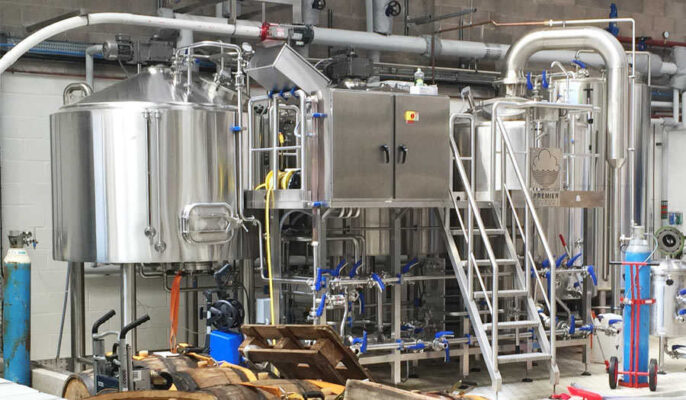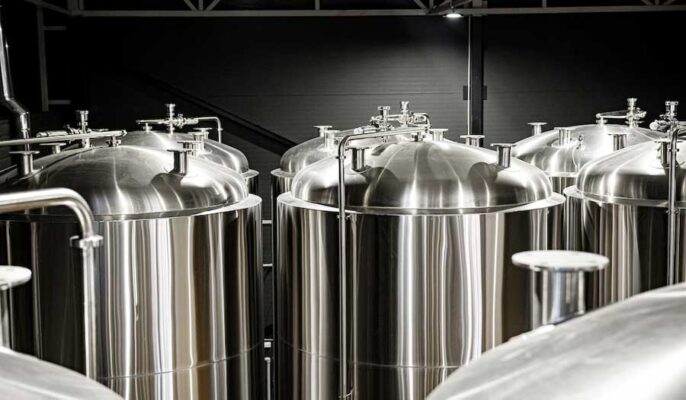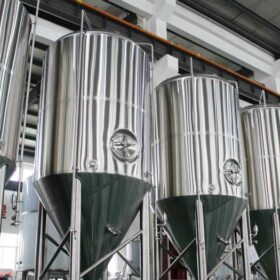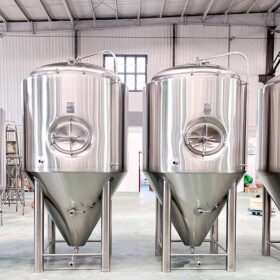Craft beer enthusiasts and entrepreneurs alike are embracing the concept of nano breweries, a small-scale brewing operation that allows individuals to create unique and artisanal beers. Nano breweries have gained popularity in recent years, offering an alternative to large-scale commercial breweries. In this article, we will explore the world of nano brewery equipment, its significance, and the process of setting up a nano brewery.
Introduction
Craft beer has experienced a renaissance, with a growing demand for distinctive flavors and locally brewed beers. Nano breweries, typically producing less than three barrels (93 gallons) of beer per batch, have emerged as an ideal platform for aspiring brewers to showcase their creativity and passion. To embark on this journey, understanding the essential equipment and its role in the brewing process is crucial.
Definition of Nano Brewery
A nano brewery is a small-scale brewing operation that focuses on producing beer in limited quantities. Unlike larger commercial breweries, nano breweries prioritize quality, craftsmanship, and experimentation. They typically produce less than three barrels (93 gallons) of beer per batch, allowing brewers to have greater control over the brewing process and create unique, artisanal beers. Nano breweries often serve as platforms for aspiring brewers to showcase their creativity and passion for brewing, catering to specific tastes and preferences. These breweries play a significant role in promoting local craftsmanship, community engagement, and the appreciation of craft beer.
Importance of Nano Brewery
Nano breweries hold significant importance within the craft beer industry for several reasons:
- Craftsmanship and Creativity: Nano breweries provide a platform for brewers to express their creativity and produce small-batch beers with meticulous attention to detail. These breweries prioritize quality over quantity, allowing brewers to experiment with unique flavors, styles, and brewing techniques. The focus on craftsmanship ensures that each beer is crafted with care and precision, resulting in a diverse range of flavorful and innovative brews.
- Local Community and Economic Impact: Nano breweries often become integral parts of their local communities. They act as gathering places for beer enthusiasts, serving as hubs for social interactions, and fostering a sense of community pride. Moreover, these breweries contribute to the local economy by creating jobs, supporting local suppliers and vendors, and attracting tourists and visitors. They play a vital role in revitalizing neighborhoods and adding vibrancy to local economies.
- Product Quality and Experimentation: With their smaller scale of production, nano breweries have the advantage of closely monitoring and controlling every step of the brewing process. This meticulous attention to detail ensures consistently high-quality beers. Additionally, nano breweries have the freedom to experiment with different ingredients, brewing techniques, and flavor profiles, pushing the boundaries of what is possible in the craft beer world. This experimentation fosters innovation and keeps the industry dynamic and exciting.
- Niche Market and Consumer Preferences: Nano breweries cater to the growing consumer demand for unique and distinct beer offerings. They often specialize in specific beer styles, flavors, or brewing philosophies, catering to niche markets and discerning beer enthusiasts. By focusing on quality and craftsmanship, nano breweries can create a loyal customer base that appreciates the attention to detail and the distinct characteristics of their beers.
- Reviving Brewing Traditions: Nano breweries often embrace traditional brewing methods and styles, preserving cultural heritage and reviving brewing traditions that may have been overshadowed by larger commercial breweries. They give brewers the opportunity to experiment with forgotten recipes, indigenous ingredients, and local brewing techniques, thereby celebrating and preserving brewing traditions that may have otherwise been lost.
Overall, nano breweries play a crucial role in promoting innovation, community engagement, and the art of craft brewing. They contribute to the growth and diversification of the craft beer industry while providing unique and memorable beer experiences for consumers.

Key Components of Equipment
Setting up a nano brewery requires several key components of equipment to ensure a successful brewing process. Let’s explore these components in detail:
- Fermentation Vessels: Fermentation vessels are the heart of any brewery. In a nano brewery, these vessels are typically smaller in size but designed to maintain optimal conditions for yeast activity and flavor development. Commonly used options include stainless steel or food-grade plastic conical fermenters. These vessels provide ease of cleaning and allow for precise temperature control, ensuring consistent fermentation results.
- Brewing Kettles: Brewing kettles are where the magic happens. They are responsible for heating and boiling the ingredients essential for brewing, such as malt, hops, water, and yeast. In nano breweries, smaller brewing kettles are often preferred. These kettles provide precise temperature control, allowing brewers to achieve consistent brewing results batch after batch.
- Cooling Systems: Maintaining the right temperature during the brewing process is crucial for optimal flavor extraction and yeast performance. Cooling systems come into play after boiling the wort. Plate chillers or immersion chillers are commonly used in nano breweries to rapidly cool down the wort, preventing off-flavors and promoting clarity in the final product.
- Filtering Systems: Some nano breweries choose to incorporate filtering systems to achieve crystal-clear beer. These systems remove any sediment or particles that may affect the beer’s appearance or mouthfeel. Cartridge filters, diatomaceous earth filters, or plate filters are commonly employed to achieve the desired level of filtration.
- Control and Monitoring Systems: Maintaining precise control over the brewing process is essential for consistency and quality. Nano breweries utilize control and monitoring systems to regulate temperature, monitor fermentation progress, and automate certain tasks. Temperature controllers, digital hydrometers, and software for data logging and analysis are examples of control and monitoring systems used in nano breweries.
- Other Essential Equipment: Besides the key components mentioned above, nano breweries require additional equipment to support their operations. This includes pumps for transferring liquids between vessels, hoses and fittings for connecting various components of the brewing system, kegs or bottles for packaging the finished beer, cleaning and sanitization equipment to maintain hygiene standards, and a reliable water supply with proper filtration to ensure the quality of the brewing process.
These key components of equipment work in harmony to create a controlled and efficient brewing environment, allowing nano breweries to produce high-quality and consistent beers that cater to the unique tastes and preferences of their target audience.
Setting up a Nano Brewery
Setting up a successful nano brewery involves careful planning and execution. Here are some crucial considerations:
Location
When choosing a location for your nano brewery, consider factors such as proximity to your target market and accessibility. Being located in an area with a high concentration of craft beer enthusiasts can help attract customers and generate interest in your brewery. Additionally, consider the zoning regulations in your area to ensure compliance with local laws regarding brewery operations. Adequate space for expansion is also essential, as you may want to scale up your production in the future.
Licensing and Regulations
Before opening your nano brewery, it is crucial to obtain the necessary licenses and permits required by local authorities. These may include brewing licenses, permits for selling alcohol, health department certifications, and compliance with safety regulations. Research the specific requirements in your area and ensure that you meet all legal obligations to operate your brewery without any issues.
Brewery Layout and Design
Designing an efficient and well-organized brewery layout is key to maximizing productivity and workflow. Consider the flow of operations from ingredient storage and preparation to the brewing process and packaging. Ensure that the layout allows for easy movement and minimizes the risk of contamination. Create designated spaces for brewing equipment, storage areas for ingredients and finished products, and comfortable workspaces for your brewing team. A thoughtful layout can improve efficiency and make operations more seamless.
Equipment Sourcing and Installation
When setting up your nano brewery, invest in reliable and high-quality equipment. Research reputable suppliers who specialize in brewing equipment and compare prices to find the best value for your budget. Consult with experienced brewers or industry professionals to get recommendations on the most suitable equipment for your specific brewing needs. Once you have acquired the necessary equipment, ensure proper installation and setup. Follow manufacturer guidelines and seek assistance from professionals if needed to ensure that the equipment is correctly installed and functioning optimally.
By carefully considering these aspects of setting up a nano brewery, you can lay a solid foundation for your business. Proper planning, compliance with regulations, thoughtful design, and quality equipment are essential for a successful and thriving nano brewery operation.
Brewing Process
The brewing process in a nano brewery involves several key steps, each contributing to the creation of unique and high-quality beers. Here is an overview of the brewing process:
- Recipe Development: Crafting unique beer recipes is a fundamental aspect of nano brewing. Brewers experiment with different combinations of malts, hops, yeast strains, and adjuncts to create distinctive flavors and aromas. Recipe development requires careful consideration of ingredient proportions, mashing temperatures, and fermentation parameters to achieve the desired beer profile.
- Mashing and Fermentation: The brewing process begins with mashing, where grains are mixed with hot water in a mash tun. Enzymes present in the malt convert starches into fermentable sugars, creating a sweet liquid known as wort. The wort is then transferred to the fermentation vessel, and yeast is added. Yeast consumes the sugars in the wort and converts them into alcohol and carbon dioxide through the process of fermentation. Temperature control during fermentation is crucial to achieve the desired flavors and prevent off-flavors from developing.
- Conditioning and Carbonation: After primary fermentation, the beer undergoes a period of conditioning. Conditioning allows flavors to mature, any remaining yeast or sediment to settle, and the beer to achieve better clarity. Depending on the beer style, this can take anywhere from a few days to several weeks. Carbonation is then introduced to the beer to create the desired level of fizziness. This can be achieved by adding a precise amount of sugar to the beer, allowing it to naturally carbonate, or by force-carbonating using carbon dioxide.
- Packaging and Storage: Once the beer has undergone conditioning and carbonation, it is ready for packaging. Nano breweries typically package their beer in kegs, bottles, or cans. Kegs are commonly used for on-tap service, while bottles and cans cater to retail sales. Packaging should be carried out under sanitary conditions to maintain the beer’s quality. Proper sealing and storage are essential to preserve the freshness and flavors of the beer.
- Quality Control: Throughout the brewing process, quality control measures are essential to ensure consistency and excellence in the final product. This includes regular monitoring of temperature, gravity, pH levels, and sensory evaluation. Testing the beer at different stages allows brewers to make adjustments and maintain the desired flavor profile. Quality control protocols help identify any potential issues early on, ensuring that only the highest-quality beer reaches consumers.
Each step of the brewing process requires careful attention to detail, precise measurements, and a deep understanding of the ingredients and techniques involved. By mastering the brewing process, nano breweries can produce unique, flavorful, and high-quality beers that satisfy the discerning tastes of their customers.
Benefits of Nano Brewery
Nano breweries offer several advantages over larger-scale operations:
Craftsmanship and Creativity
Nano breweries provide a platform for brewers to express their creativity and produce small-batch beers with meticulous attention to detail. These breweries focus on quality over quantity, allowing brewers to experiment with unique flavors, styles, and brewing techniques. This craftsmanship and dedication to innovation result in beers that stand out in terms of taste and complexity.
Local Community and Economic Impact
Nano breweries often become community gathering spots, attracting beer enthusiasts and locals alike. They contribute to the local economy by creating jobs, supporting local suppliers, and generating tourism. These breweries become hubs for cultural exchange, fostering a sense of pride and identity within the community.
Product Quality and Experimentation
With a smaller scale of production, nano breweries have the advantage of closely monitoring and controlling every step of the brewing process. This meticulous attention to detail ensures consistently high-quality beers. Additionally, nano breweries have the freedom to experiment with different ingredients, brewing techniques, and flavor profiles, pushing the boundaries of what is possible in the craft beer world.

Marketing and Promotion
Marketing and promotion are crucial for the success of a nano brewery. Here are some key aspects to consider when developing your marketing strategies:
Branding and Packaging
Creating a strong and memorable brand identity is essential for standing out in the competitive craft beer market. Develop a brand that reflects your brewery’s values, personality, and target audience. Design a distinctive logo and labels that visually communicate your brand story and differentiate your beers on the shelf. Thoughtful and attractive packaging can significantly influence consumer perception and drive purchase decisions.
Online Presence and Social Media
In today’s digital age, having a strong online presence is vital for reaching and engaging with your target audience. Create a professional website that showcases your brewery, beers, and brewing process. Optimize your website for search engines to increase visibility. Leverage social media platforms such as Instagram, Facebook, Twitter, and YouTube to connect with beer enthusiasts, share engaging content, and build a community around your brand. Regularly post updates, behind-the-scenes glimpses, beer releases, and promotions to keep your audience engaged and excited.
Events and Collaborations
Participating in beer festivals, hosting brewery tours, and organizing special events are effective ways to expose your nano brewery to a wider audience. These events provide opportunities to showcase your beers, interact with potential customers, and receive valuable feedback. Collaborate with local businesses, artists, and musicians to create unique experiences and tap into new customer networks. By organizing or participating in events, you can enhance brand visibility and forge meaningful connections within the community.
Online Sales and Distribution
Consider offering online sales and direct-to-consumer shipping options to expand your reach beyond your local area. Develop a user-friendly e-commerce platform that allows customers to order your beers conveniently. Explore partnerships with local bottle shops, restaurants, and bars to distribute your beers to a wider audience. Networking with distributors can help you secure placement in retail stores and tap into new markets.
Brand Ambassadors and Influencers
Engage with beer enthusiasts and influencers who align with your brand values. Collaborate with them to promote your beers through reviews, sponsored content, and social media shout-outs. Their endorsement can help increase brand awareness and reach new audiences. Consider selecting brand ambassadors or influencers who have a genuine passion for craft beer and can authentically represent your brand.
Community Engagement
Connect with your local community and support local causes. Sponsor or participate in charity events, partner with local organizations, and contribute to community initiatives. Engaging with the community fosters brand loyalty, builds positive brand perception, and establishes your nano brewery as a valuable member of the local ecosystem.
By implementing a comprehensive marketing strategy that encompasses branding, online presence, events, collaborations, distribution, and community engagement, you can effectively promote your nano brewery and establish a strong foothold in the craft beer market.

Challenges and Considerations
While nano breweries offer exciting opportunities, they also face certain challenges. Here are a few factors to consider:
Financial Investment and Return on Investment
Setting up and operating a nano brewery requires a significant financial investment. Expenses include equipment, ingredients, licensing fees, marketing, and overhead costs. It is crucial to carefully plan and manage finances to ensure profitability and a sustainable business model.
Quality Control and Consistency
Maintaining consistent beer quality is a challenge for any brewery, and nano breweries are no exception. Attention to detail, proper sanitation practices, and quality control measures are essential to ensure that every batch meets the brewery’s standards. Implementing quality control protocols and continuously improving processes are crucial for success.
Competition and Market Saturation
The craft beer market is highly competitive, with a plethora of breweries offering diverse options. Nano breweries must find their niche and differentiate themselves to attract loyal customers. Market research, understanding consumer preferences, and offering unique and innovative beer styles can help nano breweries stand out in a saturated market.
Conclusion
Nano brewery equipment has revolutionized the craft beer industry, allowing individuals to bring their creative beer concepts to life. These small-scale breweries provide an avenue for innovation, craftsmanship, and community engagement. By focusing on quality, local impact, and experimentation, nano breweries have carved a niche in the ever-evolving world of craft beer.







Pingback: Whole Grain Brewing: A Beginner’s Guide